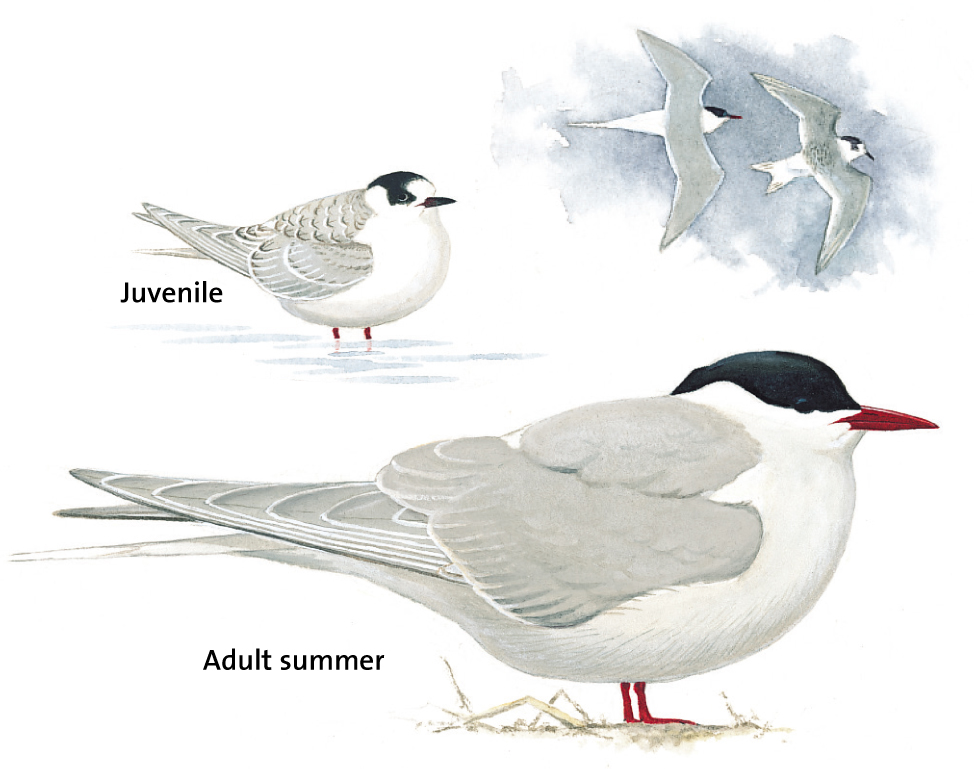
Little Tern
Sternula albifrons

SIZE AND DESCRIPTION
23cm. Smallest of the black-capped ‘white’ terns. The tail is short and barely forked, and the wings are narrow. Breeding adult has a neat white forehead, yellow bill with a black tip, and orange legs. Winter adult and juvenile are duller.
VOICE
Chattering calls.
HABITAT
Summer visitor to northern Europe. Rather scarce and scattered in Britain. Nests in colonies on flat sandy and shingly beaches, on migration may be seen offshore from any coast.
FOOD AND HABITS
Diet consists of small fish and invertebrates. Often hovers, employing very rapid wingbeats, before plunge-diving. Nesting birds on beaches are sensitive to disturbance, so decreasing where it is not fully protected.
Black Tern
Chlidonias niger

SIZE AND DESCRIPTION
23cm. Small, short-tailed tern. In summer had black body and grey wings and tail. In winter head and body white but with black rear crown and half-collar, first-winter similar but upperside has scaly pattern. Bill black, legs blackish.
VOICE
Usually quiet, occasionally a sharp ‘kik’.
HABITAT
Breeds patchily across western Europe, migrates to Africa. Passage migrant in Britain, often offshore but also inland where it may linger to feed over well-vegetated marshy pools and lakes.
FOOD AND HABITS
Feeds mainly on aquatic insects, with small fish more important in winter. Most prey picked from water’s surface in graceful dipping and turning flight. Often in small parties.
Sandwich Tern
Sterna sandvicensis

SIZE AND DESCRIPTION
41cm. Large tern with pale plumage, rather short black legs, and a long and slender black bill. Breeding adults have a black crown with a shaggy crest, and a yellow tip to the bill. White forehead in winter.
VOICE
Distinctive harsh ‘kirrick’.
HABITAT
Summer visitor to northern Europe. Fairly common breeding bird in Britain, forms large colonies on beaches and islands on coastal lagoons. On migration may be seen offshore from any coast. Occasionally overwinters.
FOOD AND HABITS
Eats fish and other marine invertebrates. Nest a simple scrape in sand.
Common Tern
Sterna hirundo

SIZE AND DESCRIPTION
35cm. Grey upperparts, a black crown, and dark red legs and bill, which has a black tip. Long forked tail. White forehead in winter.
VOICE
Call is a strident ‘keeyah’ and ‘wik-kik-kik’.
HABITAT
Summer visitor to Britain, fairly common and widespread on coasts and inland. Nests on beaches and lake islands, fishes over sea and fresh water. On migration may be seen offshore from any coast.
FOOD AND HABITS
Eats fish, worms, insects, molluscs and crustaceans. Often dives for fish. Nests on dunes, salt marshes and shingle banks, in colonies or as single pairs.
Roseate Tern
Sterna dougallii

SIZE AND DESCRIPTION
38cm. Whiter than Common or Arctic Tern, stands a little taller and has longer tail streamers. Bill long, black with hint of red at base. Underside shows subtle rosy flush. Juvenile heavily marked dark grey on upperside with black cap, forehead whitens in first-winter plumage.
VOICE
A grating ‘kraaak’ and disyllabic sharp ‘ke-wick’.
HABITAT
Very widespread globally but rare in Britain, most colonies in Ireland. Migrates to Africa in winter. Nests on undisturbed rocky coasts, especially on small islands.
FOOD AND HABITS
Catches small fish especially sand-eels. Has a stiff-winged, strong flight and will plunge-dive from a greater height than Common or Arctic Tern.
Arctic Tern
Sterna paradisaea

SIZE AND DESCRIPTION
35cm. Breeds mostly by coast in northern Britain. Elsewhere generally seen on passage. Similar to Common Tern, but with a blood-red bill. In winter has a white forehead with a black bill. Tends to have longer tail streamers.
VOICE
Calls similar to those of Common Tern; also a high whistling ‘kee, kee’.
HABITAT
Summer visitor to northern Europe, in Britain very rare in south but has some huge colonies in northern England and Scotland. Nests on stony beaches and lake islands. On migration may be seen offshore from any coast.
FOOD AND HABITS
Eats fish, insects, molluscs and crustaceans. Nest a shallow scrape in grass or sand.